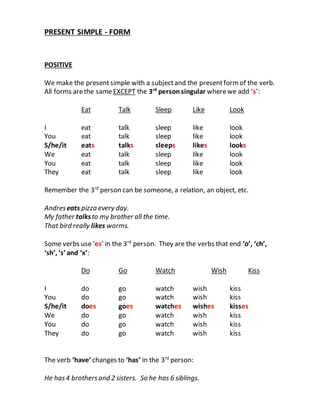
Present Simple Form
- 1. PRESENT SIMPLE - FORM POSITIVE We make the present simple with a subject and the present form of the verb. All forms are the same EXCEPT the 3rd person singular where we add ‘s’: Eat Talk Sleep Like Look I eat talk sleep like look You eat talk sleep like look S/he/it eats talks sleeps likes looks We eat talk sleep like look You eat talk sleep like look They eat talk sleep like look Remember the 3rd person can be someone, a relation, an object, etc. Andres eats pizza every day. My father talks to my brother all the time. That bird really likes worms. Some verbs use ‘es’ in the 3rd person. They are the verbs that end ‘o’, ‘ch’, ‘sh’, ‘s’ and ‘x’: Do Go Watch Wish Kiss I do go watch wish kiss You do go watch wish kiss S/he/it does goes watches wishes kisses We do go watch wish kiss You do go watch wish kiss They do go watch wish kiss The verb ‘have’ changes to ‘has’ in the 3rd person: He has 4 brothers and 2 sisters. So he has 6 siblings.
- 2. Verbs that end in ‘y’ have 2 rules: 1. If the letter before the ‘y’ is a VOWEL, you add ‘s’. For example: ‘stay’ has the vowel ‘a’ before the ‘y’ (stay) = ‘stays’. 2. If the letter before the ‘y’ is a CONSONANT, you remove the ‘y’ and add ‘ies’. For example: ‘fly’ has the consonant ‘l’ before the ‘y’ (fly) = ‘flies’. Stay Play Fly Worry I stay play fly worry You stay play fly worry S/he/it stays plays flies worries We stay play fly worry You stay play fly worry They stay play fly worry Modal verbs (verbs like: can, could, might, may, should) do not change for 3rd person singular. Can Might Could I can might could You can might could S/he/it can might could We can might could You can might could They can might could Remember modal verbs are used with other verbs. The other verb does not change in the 3rd person either: He can speak English She could go to the cinema
- 3. NEGATIVE The verb ‘be’ uses ‘not’ when making negatives but all other verbs (apart from modal verbs) need the auxiliary verb ‘do’ in the negative = do not/does not We use ‘do not’ with I, you, we and they. We can contract to ‘don’t’ We use ‘does not’ with he, she and it. We can contract to ‘doesn’t’ IMPORTANT: the auxiliary verb gives us the information about the 3rd person (‘doesn’t’) therefore the main verb goes back to the base form. In English it is not possible to have 2 verbs giving the same information. ‘Work’ ‘Enjoy’ (contracted forms) I do not work I don’t enjoy You do not work You don’t enjoy S/he/it does not work S/he/it doesn’t enjoy We do not work We don’t enjoy You do not work You don’t enjoy They do not work They don’t enjoy She does not work for that company anymore. He doesn’t enjoy playing football. Remember this applies even when the verb changes from ‘ies’, for example with the verb ‘fly’ He flies airplanes He doesn’t fly airplanes The exception (as well as the verb ‘be’) is modal verbs. Here, we simply use ‘not’ Can Cannot Can’t Could Could not Couldn’t Might Might not Mightn’t I can’t come to work today. He couldn’t decide what to do. We might not have time to see the movie.
- 4. QUESTION With all verbs (apart from ‘be’ [see ‘To Be’] and modals) we need to use the auxiliary verb ‘do’ (like the negative) in questions = do or does We use ‘do’ with I, you, we and they We use ‘does’ with he, she and it IMPORTANT: like with the negative form, the auxiliary verb gives us the information about the 3rd person (‘does’) therefore the main verb goes back to the base form. In English it is not possible to have 2 verbs giving the same information. The ‘do’ or ‘does’ goes before the subject: Do you play football? Do we have time for a class? Does she like me? Does he want to come to my house tonight? These questions are ‘Yes/No’ questions. The answer is not the main verb but the auxiliary verb. So the first question: ‘Do you play football?’ The answer is either: Yes, I do OR No, I don’t (do not) NOT Yes, I play The answer to ‘Does she like me?’ is either: Yes, she does OR No, she doesn’t (does not) NOT Yes, she likes Modal verbs behave like the verb ‘be’. We swap the subject and the modal to make the question: Can you come to my office? Yes, I can OR No, I can’t Could he decide what to do? Yes, he could OR No, he couldn’t
